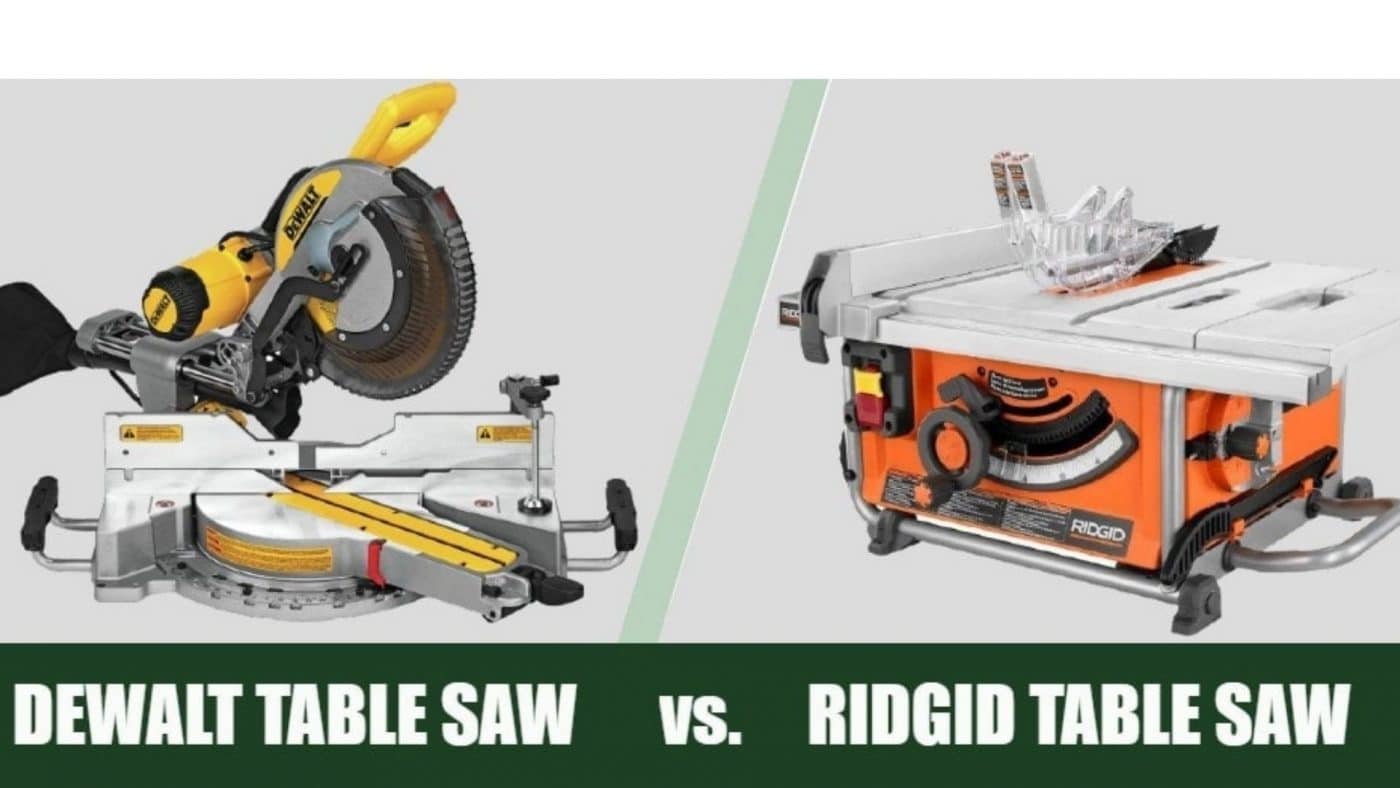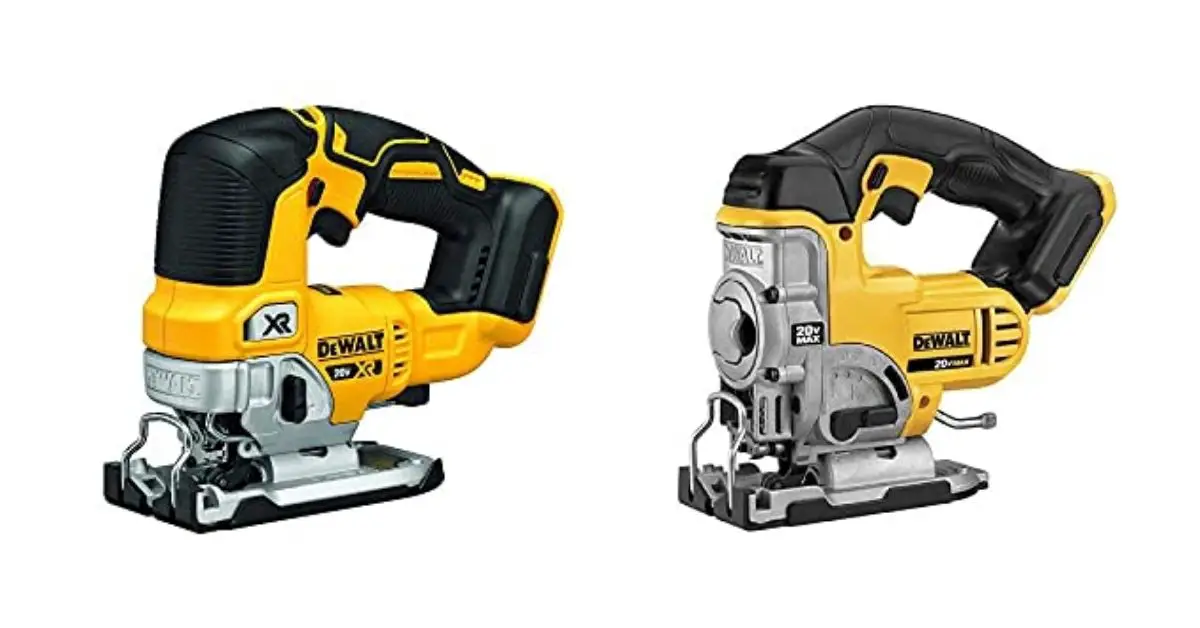Power Tools
Ridgid vs DeWalt Portable Table Saw
Ridgid and DeWalt are two of the biggest power tool companies in the United States. DeWalt has a greater global presence than Ridgid, and they also seem to possess better technologies. And while that bodes well for woodworkers that demand quality, it’s not such good news if you’re on a shoestring budget.
That’s why some gravitate towards Ridgid table saws—they are much cheaper! Ridgid power tools offer decent performances and are affordable, but the trade-off is usually long-term durability.
So, should you buy a Ridgid or a DeWalt table saw? How do the two brands compare? What are the key distinguishing factors between a DeWalt and a Ridgid table saw?
Ridgid vs. DeWalt: What are the differences?
Power
DeWalt models have seemingly more powerful than their Ridgid counterparts. Power is an important consideration for buying a table saw, especially if you routinely work with framing lumber and hardwood.
DeWalt saws pack lots of power into their small frames. It would take a Ridgid with a much bigger engine to match the performance of a smaller DeWalt saw.
DeWalt saws are indisputably more powerful and energy-efficient. The company’s superior technology allows them to cram so much power in such compact form factors.
Precision
Even though DeWalt saws lack nothing in cutting and measuring accuracy, Ridgid saws are marginally more precise. They tend to have very beginner-friendly precision settings.
Ridgid saws allow you to work faster and without too much material waste. They have oversized handles that are very easy to manipulate. You can accurately measure and cut projects on a Ridgid saw, even if you’re relatively new to woodworking.
Portability
Of the two saw brands, DeWalt consistently makes saws with a smaller form factor. Despite being so powerful, most DeWalt saws are extremely compact. Again, they achieve this balance through advanced technology. Ridgid doesn’t have the biggest or clunkiest saws, but you can’t compare them to the sleek, lightweight build most DeWalt saws have. A portable saw is handy for performing heavy-duty tasks wherever your job takes you.
Price
DeWalt saws tend to be more expensive than Ridgid saws. They tend to feature high-quality parts and solid builds, so it makes sense that they would attract a bigger price.
Ridgid saws are cheaper, and therefore many newbies prefer them when they’re not ready to fully commit to the trade. It’s a good strategy to start with a cheaper tool when learning the ropes, then upgrade when you feel the need for more features. In that respect, a Ridgid saw is always the best tool to buy.
Ridgid vs. DeWalt: Which should you buy?
Most of the time, seasoned woodworkers prefer DeWalt over Ridgid saws. They tend to be more reliably built and excellently suited for long-term service.
Sometimes woodworkers choose the cheaper and less powerful Ridgid saws, usually to supplement their primary table saws. They are almost as powerful as any DeWalt saw and are only limited by their low-quality construction.
Always make side-by-side comparisons of any DeWalt and Ridgid tools you’re interested in purchasing to learn the individual differences of each tool.
Ridgid and DeWalt Saws You Can Purchase on Amazon
DeWalt (DWE7485) 8 ¼-inch Compact Table Saw for Jobsite.
If you’re looking for a compact table saw for taking to job sites, then the DWE7485 should be high on your list. It is compactly built to facilitate quick and easy shipping between locations, yet it is powerful enough to manage 24.5-inch rip cuts on dimensional plywood and OSB sheets.
Power is supplied by its 15-amp motor, which delivers up to 5,800 RPM. The compact table saw has a metal roll cage around it, a testament to how durable it can be even when it lives on a harsh construction site.
The DWE7485 is the ideal job site companion for many seasoned woodworkers, especially since it also comes with onboard tool storage. You can securely carry components like the push stick on the table saw and access it easily when it’s needed.
The 8 ¼-inch table saw weighs about 54 pounds, has an ideal blade length of 4 inches, and works with 110v outlets. It comes with a fence, an anti-kickback pawl, a push stick, a riving knife (non-thru cut), two-blade change wrenches, and a modular guard system.
DeWalt (DWE7491RS) 10-inch Table Saw
With a rip capacity of 32 ½ inches, there isn’t much that the DeWalt DWE7491RS cannot cut through. This 10-inch table saw features a 22-inch long blade, a 15.0-amp high-torque motor with a no-load speed of 4,800 RPM, and a traditionally reliable DeWalt build.
Though it is compact, it is not meant to be. This job site table saw is built for power, and even though it weighs 110 pounds, it is extremely portable because it is mounted on a rolling stand.
It is a professional tool with a beginner-friendly build that includes a telescoping fence system (rack and pinion) that’s very easy to use. The rolling stand enhances stability and can be taken down and set up in minutes.
Is this saw good enough for you? Well, it can cut through pressure-treated lumber and hardwood, so you be the judge.
Ridgid R4512 10-inch Table Saw on Cast Iron.
While DeWalt equips saws with roll cages, Ridgid chooses a different path. In this instance, the 10-inch table saw features a highly stabilizing cast iron table. It minimizes vibrations extremely well and adds a chunk of weight to the tool.
Under its hood is a 13-amp motor capable of 3,450 RPM. The table saw equips users with a clamping aluminum rip fence (front and back) with extra-large guides. This setup is ideal for smooth, quick, and precise adjustments.
It also has built-in accessory slots, so you have plenty of onboard storage for items like your push stick and riving knife.
At 267 pounds, however, this table saw is far from portable. The design is very good for cutting down vibration, not so much for transporting from one job site to the next.
Why You Should Trust Us
At Woodworking Tool Guide, we know one size doesn't fit all! We cater to every woodworker, from beginner to pro, with insights and recommendations tailored to your skill level, project needs, and budget. We take the guesswork out of choosing the right tools, whether you're tackling your first crafting a masterpiece for the ages. So grab your chisel, join our community, and let's build something amazing together!
Woodworking Tool Guide wasn't just born, it sprouted from a seed of passion for the craft. What started as a joyful exploration blossomed into a trusted online haven for fellow enthusiasts like you. We pour our love into meticulously chosen review selections, meticulous hands-on testing, and lab-backed insights, all to empower you with reliable, comprehensive information you can build on. So, grab your tools, trust our guidance, and let's build something beautiful together!
Passion-Driven Expertise
Our journey started with a shared love for woodworking. The team behind the Woodworking Tool Guide is comprised of individuals who are not just writers but passionate woodworkers themselves. This shared enthusiasm ensures that our content is crafted with a deep understanding of the craft and an authentic appreciation for quality tools.
Top Tool Guides Online
Woodworking Tool Guide has rapidly ascended to become one of the premier online destinations for tool guidance. Our commitment to excellence and the accuracy of our information has positioned us as a reliable source for both beginners and seasoned woodworkers seeking trustworthy advice on the best tools for their projects.
User-Centric Approach
Our content caters to every woodworker, from rookies just starting out to seasoned pros tackling intricate projects. We tailor our insights and recommendations to your skill level, project needs, and budget, ensuring you find the perfect tools to match your unique woodworking journey. So step into your workshop, grab your tool belt, and let Woodworking Tool Guide be your trusted companion as you craft your masterpieces.
Continuous Support and Innovation
Woodworking is an ever-evolving craft, and so is our commitment to supporting you. We are dedicated to bringing you the latest information on woodworking tools, techniques, and trends. Our team is actively working to expand our content and bring you more valuable insights, ensuring that you stay well-informed in your woodworking adventure.
Hands-On Experience
Ditch the endless research rabbit hole! At Woodworking Tool Guide, we believe in actionable advice, not armchair analysis. We get our hands dirty, putting every tool through its paces in real-world woodworking scenarios. Whether it's the precision of a table saw, the versatility of a router, or the tactile satisfaction of a handplane, we test for performance, durability, and user-friendliness. No more sifting through dry specs – we deliver practical insights you can trust to transform your woodworking dreams into reality.
Woodworking Tool Guide isn't just a review site, it's your trusted companion on the sawdust-filled path to woodworking mastery. Our expert team, led by veteran David Jones, meticulously tests and explains tools in terms you understand. We cut through the jargon, bias, and confusion with real-world insights and honest evaluations. Join our passionate community, where decades of experience, cutting-edge knowledge, and shared love for the craft come together to guide you every step of the way. So grab your chisel, buckle up, and let's embark on this exciting woodworking adventure, together!









